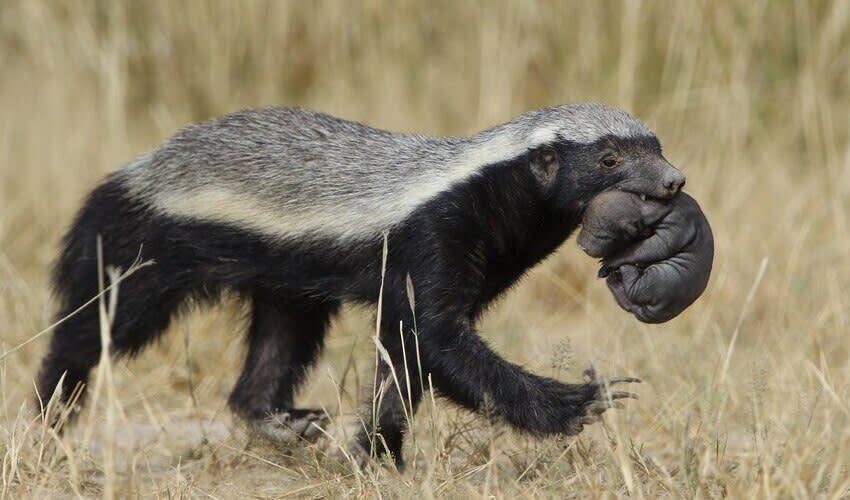The Honey Badger, often referred to as the ratel, is one of the most notorious and resilient members of the weasel family (Mustelidae), celebrated for its strength, tenacity, and fearsome reputation. Found across a wide range of habitats in Africa, the Middle East, and the Indian subcontinent, the honey badger has adapted to environments ranging from dense forests to arid deserts.
Their physique is built for survival. They possess a remarkably large head in proportion to their body, small eyes shielded by thick eyelids, and a muscular neck and shoulders that provide the strength necessary for digging and combat. Their front feet are equipped with broad, robust claws that are essential for excavating burrows, climbing, and seizing prey, while their smaller rear feet facilitate swift and agile movement.
One of the honey badger’s most distinctive features is its skin, which is incredibly thick, loose, and almost impervious to traditional predator attacks, including bites and stings. This physical trait allows them to twist and turn within their skin to fend off or counterattack predators even when seemingly caught. Additionally, their dark fur with a striking white or grey mantle running from their head down their back makes them easily recognizable, though coloration can vary among subspecies.
Honey badgers exhibit remarkable versatility in their behavior. While primarily nocturnal, they are known to forage during the day, especially in areas undisturbed by human activity. Their diet is omnivorous but leans heavily towards carnivory, with a preference for snakes, including venomous species, small mammals, birds, eggs, and frogs. Their powerful jaws and sharp teeth enable them to consume virtually every part of their prey, including bones.
Distribution
 Algeria
Algeria Angola
Angola Benin
Benin Botswana
Botswana Burkina Faso
Burkina Faso Burundi
Burundi Cameroon
Cameroon Central Af. Rep.
Central Af. Rep. Chad
Chad Congo-Brazzaville
Congo-Brazzaville Côte D’ivoire
Côte D’ivoire DR Congo (Kinshasa)
DR Congo (Kinshasa) Djibouti
Djibouti Equatorial Guinea
Equatorial Guinea Eritrea
Eritrea Eswatini
Eswatini Ethiopia
Ethiopia Gabon
Gabon Gambia
Gambia Ghana
Ghana Guinea-Bissau
Guinea-Bissau Guinea
Guinea India
India Iran
Iran Iraq
Iraq Israel
Israel Jordan
Jordan Kazakhstan
Kazakhstan Kenya
Kenya Kuwait
Kuwait Lebanon
Lebanon Liberia
Liberia Malawi
Malawi Mali
Mali Mauritania
Mauritania Morocco
Morocco Mozambique
Mozambique Namibia
Namibia Nepal
Nepal Niger
Niger Nigeria
Nigeria Oman
Oman Pakistan
Pakistan Qatar
Qatar Rwanda
Rwanda Saudi Arabia
Saudi Arabia Senegal
Senegal Sierra Leone
Sierra Leone Somalia
Somalia South Africa
South Africa Sudan
Sudan Tanzania
Tanzania Togo
Togo Turkmenistan
Turkmenistan UAE
UAE Uganda
Uganda Uzbekistan
Uzbekistan Yemen
Yemen Zambia
Zambia Zimbabwe
ZimbabweAnything we've missed?
Help us improve this page by suggesting edits. Glory never dies!
Suggest an editGet to know me
Terrestrial / Aquatic
Altricial / Precocial
Polygamous / Monogamous
Dimorphic (size) / Monomorphic
Active: Diurnal / Nocturnal
Social behavior: Solitary / Pack / Herd
Diet: Carnivore / Herbivore / Omnivore / Piscivorous / Insectivore
Migratory: Yes / No
Domesticated: Yes / No
Dangerous: Yes / No





